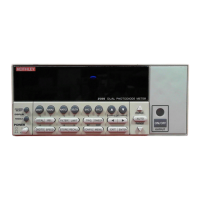F-2 Measurement Considerations Models 2500 and 2502 User’s Manual
NOTE This appendix summarizes considerations to make accurate measurements using
the Model 2500. For comprehensive information on these and additional mea-
surement considerations, refer to the Low Level Measurements handbook, which
is available from Keithley.
Low current measurements
Low current measurements are subject to a number of error sources that can have a serious
impact on measurement accuracy. These aspects are covered in the following paragraphs.
Leakage currents
Leakage currents are generated by high resistance paths between the measurement circuit
and nearby voltage sources. These currents can considerably degrade the accuracy of low
current measurements.
One way to reduce leakage currents is to use good quality insulators when building the test
circuit. Some good quality insulators include Teflon, polyethylene, and sapphire. Avoid
materials such as phenolics and nylon.
Humidity may also degrade low current measurements. The amount of water an insulator
absorbs will vary depending on the insulator. It is best to choose an insulator on which
water vapor does not readily form a continuous film. Sometimes this is unavoidable if the
material being measured absorbs water easily, so it is best to make the measurements in an
environmentally controlled room. In some cases, an insulator may have ionic contami-
nants and, especially in high humidity, a spurious current may be generated.
Noise and source impedance
Noise can seriously affect sensitive current measurements. This section discusses how
DUT (device under test) resistance and capacitance affect noise performance.
DUT resistance
The resistance of the DUT will affect the noise performance of the ammeters. As the DUT
resistance is reduced, the noise gain of the ammeter will increase. Noise gain can be given
by the following equation:
Output V
NOISE
= Input V
NOISE
(1 + R
F
/R
DUT
)
where;
• Output V
NOISE
is the noise seen at the output of the ammeter.
• Input V
NOISE
is the noise seen at the input of the ammeter.
•R
F
is the internal feedback resistance for the ammeter.
•R
DUT
is the resistance of the DUT.
Test Equipment Depot - 800.517.8431 - 99 Washington Street Melrose, MA 02176
TestEquipmentDepot.com

